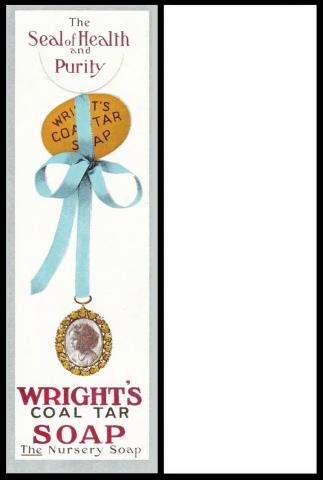
Now the tar barrel racing we spoke of yesterday is not the only one in the area, for on the second Saturday of November they also do it in Hatherleigh, where it is accompanied by a carnival. This one is very early in the morning, you have to get up specially - and perhaps that is also a bit of a link to it all being over by the time the customs men are on their rounds...
This event seems to have started in 1903.
To card chat, when I was researching yesterday`s card I was struck by the fact that tar was used because of its strong, and maybe noxious odour, as well as the way it disguised all trace of what was beneath it. And yet it also appears on a lot of trade cards for another reason, and that is health and hygiene.
In America you can find trade cards where is it is recommended to combat colds, coughs (especially whooping cough in children), sore throats, lung infections, toothache, consumption, bronchitis, and Sines` Syrup of Tar is even advertised as "Cures all Pulmonary Diseases"
Back in England, the top brand was Wright`s Coal Tar Soap. This was created in 1860 by William Valentine Wright, from the liquid by-product that occurred when coal was distilled to make coke or coal gas. He had been born in Suffolk but then opened a small business in London as a wholesale druggist and chemist. This was at the romantic sounding address of Old Fish Street Hill, and it was very close to Billingsgate Market. He did not call it Wright`s Coal Tar Soap, he called it "Sapo Carbonis Detergens" - which is Latin, for, in order, soap, coal, polish (as in rubbing, not furniture polish, though the truth is that the "polish" bit of furniture polish actually means the way it is applied and not the name of the substance)
Anyway Mr. Wright somehow acquired a source for this liquid, and his soap was seemingly inspired by the local farmers from his Suffolk youth - this was a practise which had been going on for centuries, and even the Roman poet Virgil mentioned shepherds using pitch and bitumen on their flocks to cure itching and sores, even what was later known as the mite damage, scab.
For some reason though this by-product was so well known to farmers, it had primarily always been used in industry as a preservative for fencing (which would come to be known as creosote), and for making a hard weather proof surface for local roads. You can see that on card 10 /24 of Priory Tea`s "I-Spy Men at Work" (1959). It was also used in the railway industry for making sure that the wooden structure that supported the iron rails did not decay.
Coal tar then became part of many popular medicines for human complaints involving itching and dryness, things like eczema, and dermatitis, as well as dandruff. It was one of the constituent parts of paracetamol too. There were always certain areas of the body that it was unsuitable for, and also you were told you should not use it on areas where the skin is broken and as yet unhealed, or where infection has set in close to the surface.
Then, in 2005, along with several other similar products, Wright`s Coal Tar Soap was banned. This came about because it was linked with cancer, amongst its users, but more tellingly amongst the employees of the factories. However this link was, rather shockingly, discovered way back in 1980.
Now you might be sitting here thinking but I have a bar upstairs I bought earlier in the week - well fear not, for it is still made, in Turkey, but to a different formula using tea tree oils, though it does still have "with coal tar fragrance" on the packaging, which is designed to resemble, as closely as possible, the original version.
